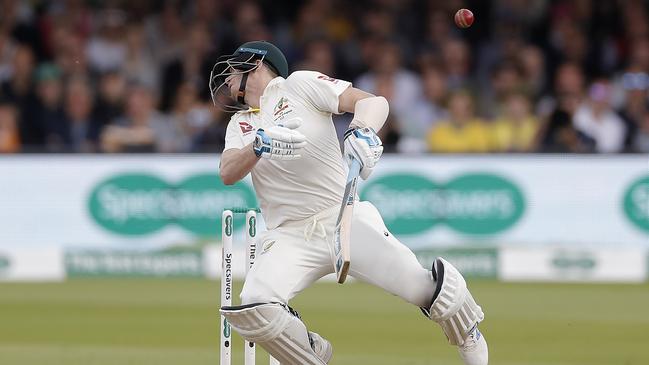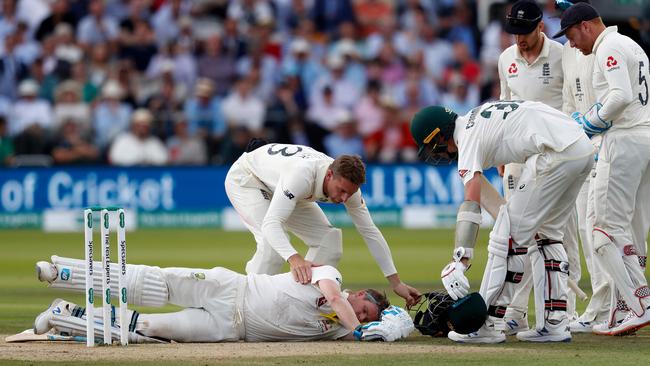Concussion has Steve Smith in doubt for third Test in Leeds
Steve Smith has delayed concussion and looks likely to miss the third Test in Leeds starting on Thursday.

Steve Smith has delayed concussion and looks likely to miss the third Test in Leeds starting on Thursday.
The loss of Smith would be a terrible blow to the Australians and could have a similar impact on the series as the ankle injury to Glenn McGrath that swung the 2005 series in England’s favour.
Smith yesterday reported a “headache, feeling slowed down, feeling in a fog ... drowsiness”.
He is the first player to be withdrawn from a Test under protocols introduced at the beginning of this series. The match referee has approved Marnus Labuschagne as a replacement.
“Steve has been closely monitored by medical staff overnight and this morning (Sunday) reported that after sleeping well, he woke with ‘a bit of a headache and a feeling of grogginess’,” Cricket Australia said in a statement.
“Steve reported that his left arm which was also struck during his innings yesterday (Saturday) was ‘much better’.
“As part of the Cricket Australia concussion protocol, repeat concussion testing of Steve Smith was also performed this morning and demonstrated some deterioration from his testing which is consistent with the emergence of the symptoms he was reporting.
“On that basis Steve has been withdrawn from the match by team doctor Richard Saw and the Australia team will lodge an application for a concussion substitute with the ICC match referee in line with the ICC protocol.”

Cricket Australia’s research reveals around a third of players will report delayed effects from concussion.
As most recoveries take a week his chances of playing the third Test at Headingley are slim.
Smith, who has scores 144, 142 and 92 in his three innings this series, will be a devastating loss for the team.
“In terms of Steve’s availability for the third Test, this will be considered over the coming days but the short turnaround to the next Test is not in his favour. Steve’s fitness will be assessed on an ongoing basis,” Cricket Australia said.
When Smith was taken to the dressing room after the blow to the neck on Saturday he was having nothing of suggestions he remain there.
At the heart of his exchange with coach Justin Langer is the insanity of sport, an area where sometimes personal safety matters less than life or death.
“By the time he walked back into the dressing room, he just couldn’t wait to get back out there again. I was saying, ‘Mate are you sure you’re OK?’,” Langer said.
“These are like my sons all right, so you’re never going to put them in harm’s way, even though you’re always in harm’s way with Test cricket. He was going, ‘Mate, I just want to get out there. I can’t get up on the honours board unless I’m out batting’.
“He was determined. All that he was worried about was that he wasn’t going to be able to play his forward defence because it was hurting with his top-hand grip.”
Minutes earlier cricket held its breath as Smith lay motionless on the ground, having fallen in much the same manner as Phillip Hughes did on that day in 2014. It went through our minds we were witnessing a similar event, we don’t know if Smith feared the same fate had visited him. Were these his last minutes?
In the crowd his wife Dani and parents watched on in terror, as Hughes’s mother and sister had five years earlier, waiting for a signal that the game was not being revisited by the nightmare of what happened at the SCG.
Smith was not at the ground when Hughes was hit, he received a call from Dani and rushed to be there. David Warner was at the SCG then and watched Smith with concern from the balcony on Saturday. Brad Haddin and Travis Head were in a similar position. They had been there when Hughes fell and were here again.
Others who say they have never completely recovered watched at home, sick in the stomach as Smith lay there, still as death. He was not wearing an arm guard when he was struck on the arm earlier, but he put one on after the blow. He was not wearing the helmet stem guard developed after Hughes’s death when he was struck in the same region as his former teammate. He still wasn’t wearing it when he re-emerged having passed the concussion tests and won the argument that getting his name on the honours board was the thing that mattered. That, and winning. Players don’t wear stem guards because they put comfort and routine above personal safety.
In the months after carrying Hughes’s coffin Michael Clarke did not wear one, but he eventually caved in to the medical staff.
Like Smith, Warner, who held Hughes’s head in the awful minutes after he was struck, doesn’t wear one either. The players say they affect their stance. They argue it wouldn’t have stopped the ball that hit Smith or the one that hit Warner during a warm-up game in Darwin and forced him from the field as his mind filled with images of what had happened to 25-year-old Hughes.
Smith is so obsessive about his gear he can’t bat unless his laces are taped down and his shoes clean.
Most batsmen have some sort of routine that resembles a madness, his is particularly acute.
Cricket Australia is moving to make stem guards compulsory after pushing through a rigorous and slow process of having their safety certified.
The players will be slow to embrace this gesture towards their safety because that is the way of elite sports people.
A study by Robert Goldman in the late 1980s found that half of athletes said they would take a drug that killed them in a year if it guaranteed immediate Olympic success.
Attitudes have changed a little to Goldman’s Dilemma, as it is known. A more recent follow-up in Australia found only 6 per cent were keen to trade their lives for medals. Still, six in 100 would give up their lives to stand on a podium.
The decision to wear a stem guard or not is not an exact correlation but the sport has rarely paused to ask itself whether the tactic of bowling a ball at a player’s head, a potentially lethal act, should be acceptable.
The debate rages in boxing.
Author Malcolm Gladwell argued to Pennsylvania students in a 2013 lecture that humans have through history and to this day needed an enormous burden of proof to change behaviour and protect life.
Elite universities like the one he was addressing still send out students to play American football despite conclusive evidence it will cause irreparable brain damage to some and kill others.



To join the conversation, please log in. Don't have an account? Register
Join the conversation, you are commenting as Logout